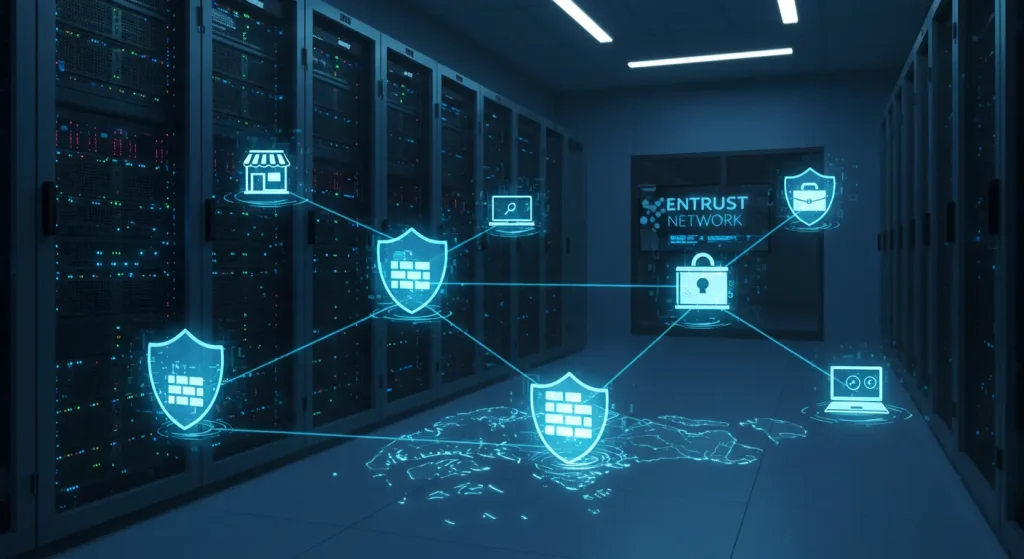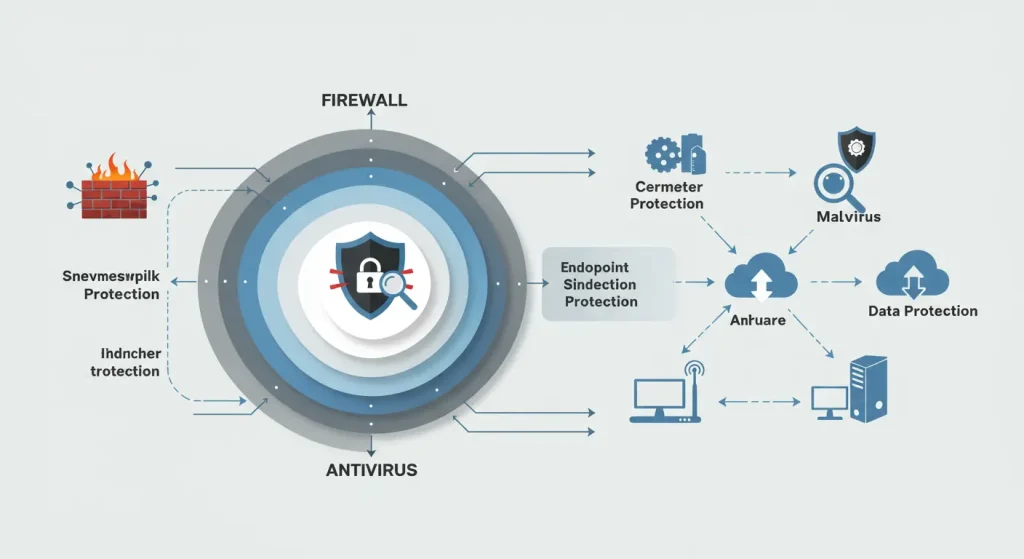

Firewall vs antivirus software — understanding the difference is key to protecting your business in Singapore’s evolving threat landscape.
Too many organisations rely on a single tool to defend against modern threats. But today’s attacks don’t follow a single playbook. They come in layers — phishing emails, unauthorised access attempts, and ransomware hidden in attachments. And that’s exactly why your defences need to be layered too.
Firewalls and antivirus software serve two different — but equally vital — roles in a comprehensive security strategy. When used together, they reduce risk, close security gaps, and protect both your network and your endpoints. This guide will clarify the difference, highlight where each fits, and show you how a managed approach helps Singapore businesses stay ahead of the threat curve.
1. What Does a Firewall Actually Do?
A firewall acts as the gatekeeper between your internal systems and the outside world. It monitors all incoming and outgoing network traffic, blocking anything that doesn’t follow predefined rules.
In practice, that means:
- Stopping unauthorised devices from accessing your systems
- Blocking known malicious IP addresses
- Managing which applications are allowed to send or receive data
- Enforcing access policies for remote users
Today’s businesses rely on next-generation firewalls (NGFWs), which go beyond basic traffic filtering. These tools inspect data packets, detect intrusion attempts, and integrate with threat intelligence feeds to respond in real time.
At Entrust Network, we deploy and manage firewalls that fit your business model — from on-site perimeter firewalls to cloud-based options for hybrid teams. That’s how we keep bad actors out before they even reach your internal systems.
2. What Does Antivirus Software Do?
While a firewall protects your network, antivirus software defends your endpoints — the laptops, desktops, and mobile devices your team uses every day.
It works by:
- Scanning files and applications for known malware
- Detecting suspicious behaviour or code
- Blocking or removing viruses, trojans, spyware, and ransomware
- Monitoring downloads, email attachments, and external drives
Modern antivirus tools also use behaviour analysis and machine learning to identify threats that don’t yet exist in signature databases — a critical layer of defence as threats evolve faster than ever.
But antivirus software only protects the device it’s installed on. It can’t stop unauthorised access or malicious traffic from reaching the device in the first place. That’s where the firewall complements it — stopping threats before they land, while antivirus handles those that get through.
Firewall vs Antivirus: The Core Differences
Both firewall and antivirus software are security essentials — but they operate at different layers, handle different risks, and work best when combined.
Here’s how they compare:
Feature | Firewall | Antivirus |
Primary Function | Controls network traffic | Detects and removes malicious software |
Scope of Protection | Network-level (before entry) | Device-level (after entry) |
Threat Prevention | Blocks unauthorised access and connections | Scans for malware on endpoints |
Key Technologies | Packet filtering, intrusion detection | Heuristic scanning, behaviour monitoring |
Examples of Use | Blocking phishing sites, limiting ports | Quarantining Trojans, detecting ransomware |
Think of your firewall as the security checkpoint outside the building, scanning everything before it gets through the door. Antivirus is the security guard inside, spotting anything suspicious that slipped past the checkpoint.
Alone, each leaves gaps. Together, they provide full-spectrum protection across your digital perimeter and internal operations.


4. Why Both Are Critical in a Business Environment
In a business setting, especially for SMEs handling sensitive data or operating hybrid teams, relying on either a firewall or antivirus alone is not enough.
Here’s why:
- Cyber threats rarely act alone. A phishing email (caught by antivirus) might include a link to a malicious site (blocked by the firewall).
- Remote work creates vulnerabilities. Home Wi-Fi, unmanaged devices, and cloud applications all increase the attack surface, and only a layered approach can keep pace.
- Data doesn’t live in one place anymore. Whether your files are in Microsoft 365, a local server, or a mobile device, they need endpoint and network protection.
- Regulatory compliance requires both. Under PDPA and related standards, organisations must demonstrate reasonable steps to prevent breaches, not just react to them.
Entrust Network ensures Singapore businesses get this dual-layer defence — deployed, monitored, and updated continuously. When firewalls and antivirus are managed as part of a unified security posture, they perform better and fail less.
5. Common Misconceptions That Lead to Security Gaps
Security failures often stem from false assumptions. Here are some of the most common — and costly — we’ve encountered:
- “We have antivirus, that’s enough.”
Antivirus only protects the device. It doesn’t stop unauthorised access, block malicious web traffic, or prevent lateral movement across a network. - “Our firewall is built into the router — we’re fine.”
Consumer-grade firewalls offer minimal control and visibility. Businesses need active management, custom rules, and intrusion prevention capabilities. - “Our business is small — no one’s targeting us.”
SMEs are often easier targets because they assume they’re not. Most ransomware campaigns are automated, looking for weak defences, not big names. - “We use Microsoft 365 — that’s secure by default.”
Microsoft 365 offers tools, but how they’re configured and maintained is what determines actual security. Without managed oversight, default settings leave gaps.
When organisations trust assumptions instead of a security strategy, vulnerabilities grow quietly. By the time a breach happens, recovery costs far outweigh what layered prevention would have required.
6. How Entrust Network Secures Your Business with Both
Entrust Network doesn’t sell software licenses. We deliver managed protection.
Here’s how we integrate firewalls and antivirus into a cohesive security posture:
- Managed firewall services
We deploy and configure enterprise-grade firewalls that control inbound and outbound traffic, enforce access policies, and stop threats before they reach your devices. - Endpoint security management
Every business device is covered with antivirus software installed, monitored, and updated automatically. We handle threat detection, incident response, and policy enforcement. - Real-time monitoring
Our team watches for unusual traffic patterns, unauthorised access attempts, and malware indicators — and acts before issues escalate. - Compliance-ready protection
We align configurations with PDPA requirements, ensuring your controls hold up during audits or incident investigations.
With Entrust Network, security isn’t piecemeal. It’s coordinated, continuously improved, and tailored to your risk profile.
7. When to Upgrade from Basic Tools to Managed Security
If your firewall or antivirus setup hasn’t changed in years — or if you’re unsure who manages them — it’s time to reassess.
Here are signs you’ve outgrown basic tools:
- You’re handling sensitive customer or financial data
Whether through invoicing systems, CRMs, or email, unprotected data flows are liabilities. - Your team works across multiple locations or devices.
Remote access increases attack surfaces. A centrally managed solution becomes essential. - You’ve experienced unexplained slowdowns or IT anomalies.
These may signal early-stage malware activity, unauthorised access attempts, or network misconfiguration. - Your compliance obligations are growing.
New contracts, industry regulations, or vendor assessments may require clearer, provable security practices. - You’ve recently expanded or plan to
New users, devices, or platforms create complexity, and with it, more opportunities for mistakes.
Entrust Network works with SMEs to bridge that gap, replacing outdated, piecemeal tools with strategic security infrastructure that scales as you do.
It’s Not About Choosing One — It’s About Managing Both
There’s no firewall vs antivirus debate. Both are critical, but neither delivers full protection on its own. True security comes from layered defence, backed by expertise, monitoring, and constant refinement.
Entrust Network helps Singapore businesses implement, manage, and optimise both solutions as part of a broader IT and cybersecurity strategy. We don’t just install software — we make sure it performs, integrates, and evolves with your business.
Ready to see how your current setup holds up? Book a security assessment with Entrust Network — and get clear answers on where you’re secure, where you’re exposed, and how to close the gap for good.
